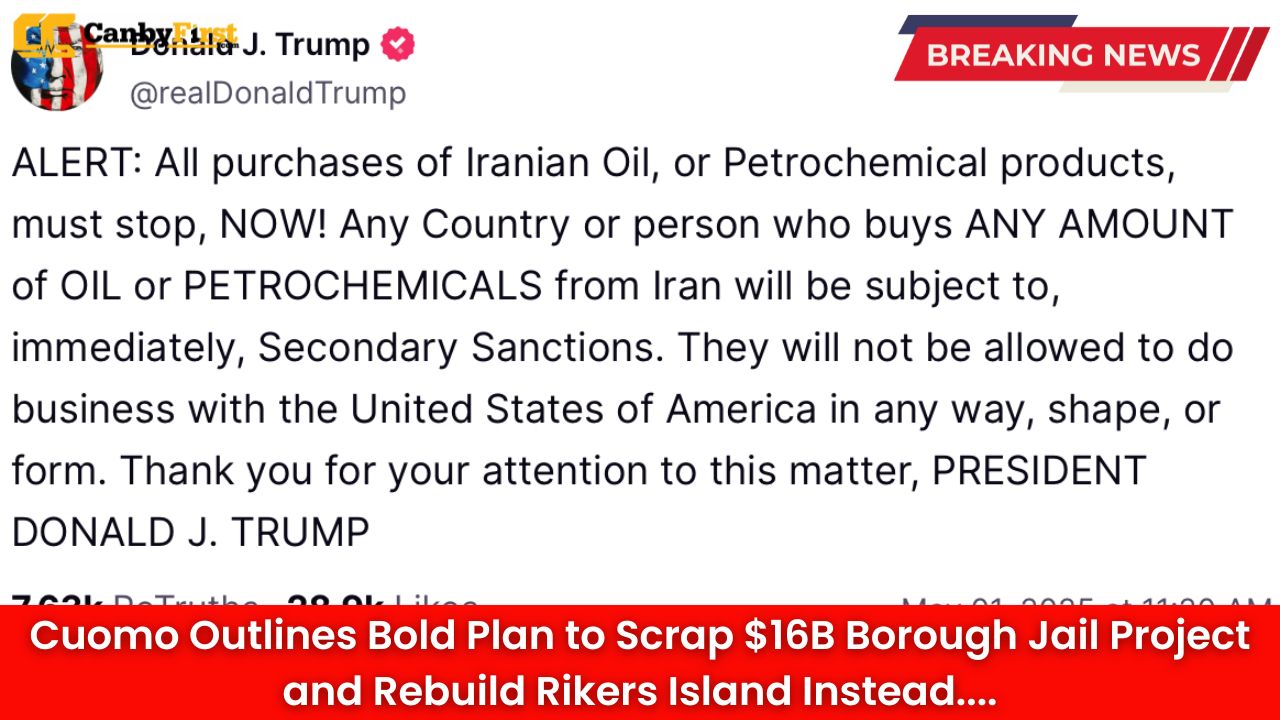Former New York Governor Andrew Cuomo has unveiled a sweeping proposal to cancel the controversial $16 billion borough-based jail plan and instead rebuild the existing Rikers Island correctional complex. Framing the idea as a “realistic and fiscally responsible” approach to criminal justice reform, Cuomo presented his blueprint this week, calling the borough jail project “a colossal mistake of politics over practicality.”
The plan comes amid growing discontent over ballooning construction costs and mounting logistical challenges tied to the city’s effort to close Rikers Island. Originally approved in 2019 under then-Mayor Bill de Blasio, the borough-based jail initiative aimed to replace the notorious island facility with four smaller jails in Manhattan, Brooklyn, Queens, and the Bronx. The project, initially estimated at $8 billion, has nearly doubled in projected costs and faces delays stretching into the next decade.
Calling Out “Fantasy” Economics and Safety Concerns
Cuomo didn’t mince words in his criticism of the city’s current course. “New York has a habit of doing the noble thing poorly,” he said, arguing that the borough jail plan was built on “a fantasy of endless money and political virtue-signalling.” According to Cuomo, spiralling costs, pressure from community groups, and inadequate planning have made the multi-borough approach unworkable.
Also Read
He proposed redirecting funds to modernize Rikers Island entirely — turning the site into a state-of-the-art correctional and rehabilitation center that meets federal standards. “We can build a modern, humane, and efficient facility right where it already exists — one that actually works for inmates, officers, and taxpayers alike,” Cuomo asserted.
The former governor’s plan, though still in early conceptual stages, would emphasize modular construction, sustainable design, and dedicated facilities for mental health and rehabilitation, positioning it as a holistic improvement over both the current Rikers layout and the borough jail plan.
Financial Friction: Budget Battles Reignited
Cuomo’s pitch comes at a time when New York City is under steep fiscal strain. Under Mayor Eric Adams, the city faces billions in projected deficits and mounting costs associated with housing and public safety. The borough jail project remains one of the most expensive civic undertakings in city history. Construction has already faced fierce resistance from local residents and councils across multiple boroughs.
A senior city budget analyst who reviewed Cuomo’s proposal noted that its timing was politically strategic. “There’s rising fatigue with the borough jail plan — costs, delays, lawsuits — and Cuomo is tapping into that frustration,” the analyst said. “If his plan gains traction, it could completely reshape the future of incarceration in New York City.”
Early estimates suggest Cuomo’s Rikers rebuild could cost between $5–7 billion — less than half of the borough jail project — with potential savings coming from centralized operations, existing infrastructure, and reduced community opposition.
A Return to Centralized Correctional Management
Cuomo’s vision would reimagine Rikers Island not just as a jail complex, but as a rehabilitative campus focused on reintegration and job programs. He described the concept as “smart incarceration,” balancing tough security with services aimed at cutting recidivism. The plan would reportedly include specialized facilities for mental health treatment, addiction recovery, and vocational training.
Critics, however, remain wary of keeping Rikers operational in any form. The facility’s long history of violence, mismanagement, and deplorable conditions led to its scheduled closure, a landmark decision lauded by reform advocates. Groups like the Campaign to Close Rikers argue that rebuilding on the same island — regardless of design — would “continue a legacy of isolation and despair.”
Cuomo countered that argument, suggesting it’s not the island but the system that needs reform. “The problem isn’t the location; it’s the neglect,” he said. “We’ve let Rikers become a symbol of failure instead of fixing what failed.”
Political Repercussions Across the City
The announcement stirred immediate reactions across New York’s political landscape. Supporters hailed Cuomo’s plan as a “common-sense alternative” amid fiscal uncertainty. Detractors dismissed it as a “rehash of old fixes” from a governor no longer in office.
Mayor Adams’ office responded cautiously, saying the city “remains committed to fulfilling the mandate to close Rikers” but would review any proposal that “ensures fiscal responsibility and safety.” City Council members in boroughs slated for new jails expressed mixed feelings, with some welcoming the possibility of avoiding unpopular projects in their districts.
Public opinion, meanwhile, appears divided. Recent polls show declining support for the borough jail plan, particularly among New Yorkers concerned about rising city debt and neighborhood safety.
Timeline and Implementation Possibilities
If Cuomo’s plan were to gain political purchase, it could take years to initiate, requiring state and city coordination, new environmental reviews, and possibly a reversal of existing legislation mandating Rikers’ closure by 2027. However, with that deadline already looking untenable due to construction delays, the political door may be open for renegotiation.
Urban planning experts note that a revamped Rikers could indeed meet modern correctional standards if properly managed and funded. The key challenge would be ensuring oversight and transparency that past administrations failed to maintain.
Broader Debate Over Jail Reform
Cuomo’s renewed interest in correctional reform has reignited a deeper debate about what justice infrastructure should look like in 21st-century New York. Does decentralization equal humanity, or can concentrated, efficiently managed facilities achieve the same goals more effectively?
Proponents of the borough-based model argue that smaller jails closer to communities improve visitation, court access, and rehabilitation outcomes. Cuomo’s camp disputes that premise, noting the increased costs, traffic congestion, and displacement associated with the borough plan.
Observers suggest the issue could become a defining one in the city’s next mayoral race, as public sentiment shifts between reform ideals and pragmatic governance.
Looking Ahead
As Cuomo reenters the public conversation, his Rikers Island overhaul could test whether New Yorkers favour cost control and consolidation over symbolic reform. His proposal, detailed but flexible, positions itself as a bridge between progressivism and pragmatism — a “fresh start built on solid ground,” as he put it.
Whether the city embraces the reboot or doubles down on decentralization remains uncertain. What’s clear is that the debate over where and how New York houses its inmates is far from over — and the future of Rikers Island, once thought settled, is once again up for negotiation.
FAQ
What is Cuomo proposing exactly?
He wants to cancel the borough-based jail construction and instead rebuild and modernize Rikers Island into a centralized correctional and rehabilitation complex.
Why is the borough jail project controversial?
Its costs have nearly doubled to $16 billion, and many neighborhoods oppose hosting new jails due to safety and zoning concerns.
How much would Cuomo’s plan cost?
Preliminary figures suggest between $5–7 billion, leveraging existing Rikers infrastructure.
Would this mean Rikers stays open indefinitely?
If adopted, yes. Rikers would be rebuilt rather than closed, effectively overturning the 2019 closure mandate.
When could the plan move forward?
Implementation would require new legislation and city-state cooperation, so even in a best-case scenario, major construction wouldn’t begin until late this decade.












